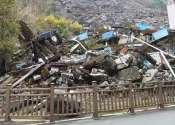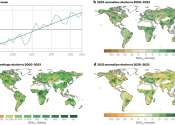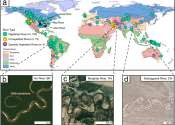Last update:
Earth Sciences news

Iron nuggets in the Pinnacles unlock secrets of ancient and future climates
Small iron-rich formations found within Western Australia's Pinnacles, which are part of the world's largest wind-blown limestone belt spanning more than 1,000km, have provided new insights into Earth's ancient climate and ...
Earth Sciences
13 minutes ago
0
0

How would California's skyscrapers survive a huge earthquake? LA County is about to find out
Faced with the prospect of an extensive, and expensive, seismic safety retrofit for its 1960s-era downtown headquarters, L.A. County decided to vet an alternative: a far newer building, located just blocks away. Not only ...
Earth Sciences
4 hours ago
0
1

AI model detects impervious surfaces in aerial images
In accordance with the German Sustainability Strategy, new impervious surfaces are to be limited to less than 30 hectares per day nationwide. In order to verify whether this target is met, it must be possible to monitor soil ...
Earth Sciences
Oct 1, 2024
0
12

Q&A: How hurricanes in the Gulf trigger storms in Virginia and North Carolina
Across the Southeastern United States, hundreds of roads are closed, power outages continue to be reported and catastrophic flooding devastated mountain towns as the fallout from Hurricane Helene swept through parts of Georgia, ...
Earth Sciences
Oct 1, 2024
0
1

Tongan volcanic eruption triggered by explosion equivalent to 'five underground nuclear bombs,' new research reveals
The Hunga Tonga underwater volcano was one of the largest volcanic eruptions in history, and now, two years later, new research from The Australian National University (ANU) has revealed its main trigger. The research is ...
Earth Sciences
Oct 1, 2024
0
103

Researcher develops program for 3D cloud tomography
Researcher David Stanley's interest in climate change has led him to develop a program to improve how we gather data to study the inside of a cloud. The program simulated multiple satellites, collecting images of a cloud ...
Earth Sciences
Sep 30, 2024
0
14

Increased sea surface cooling from hurricanes observed along the Southeast Coast of the United States in recent decades
Utilizing satellite observations and ocean reanalysis datasets, researchers have analyzed the change in sea surface cooling induced by hurricanes and the corresponding ocean-atmosphere environment along the Gulf and Southeast ...
Earth Sciences
Sep 30, 2024
0
1

European Space Agency releases new strategy for Earth observation
The European Space Agency (ESA) has released its new Earth Observation Science Strategy, Earth Science in Action for Tomorrow's World. Responding to the escalating threats from climate change, biodiversity loss, pollution ...
Earth Sciences
Sep 30, 2024
0
1

How emissions from Brazilian Pantanal's soda lakes contribute to climate change
Seasonal variations with alternating dry and rainy seasons and fluctuating levels of nutrients are factors that significantly influence greenhouse gas emissions from soda lakes in the Pantanal, considered less common than ...
Earth Sciences
Sep 30, 2024
0
20

A river is pushing up Mount Everest's peak
Mount Everest is about 15 to 50 meters taller than it would otherwise be because of uplift caused by a nearby eroding river gorge, and continues to grow because of it, finds a new study by UCL researchers.
Earth Sciences
Sep 30, 2024
0
139

New assessment suggests Anthropocene started in the 1950s
A team of Earth scientists from the Center for Marine Environmental Studies, the University of Tokyo, The Australian National University, Matsuyama University, Kyoto University, and Shimane University, has found, via a new ...

Inland waters crucial for accurate climate assessments, research suggests
Inland waters release substantial amounts of greenhouse gases, but this is rarely included in climate assessments. New research from Umeå University shows that not accounting for carbon fluxes between land and water systems ...
Earth Sciences
Sep 30, 2024
0
1

GeoTraductores democratizes science, one translation at a time
English is the dominant language for communicating research and discoveries in scientific journals. The same is true for science communication outlets such as news articles, multimedia, and press releases. However, sharing ...
Earth Sciences
Sep 30, 2024
0
9

Discovery of 3,775-year-old preserved log supports 'wood vaulting' as a climate solution
A new study published in the journal Science suggests that an ordinary old log could help refine strategies to tackle climate change.
Earth Sciences
Sep 30, 2024
0
199

Geologists discover mysterious subduction zone beneath Pacific, reshaping understanding of Earth's interior
University of Maryland scientists uncovered evidence of an ancient seafloor that sank deep into Earth during the age of dinosaurs, challenging existing theories about Earth's interior structure. Located in the East Pacific ...
Earth Sciences
Sep 28, 2024
2
318

VXS-1 Squadron continues the mission, tracking potential tropical cyclone
U.S. Naval Research Laboratory (NRL) Scientific Development Squadron ONE (VXS) 1 takes to the skies to deploy observational buoys in front of Hurricane Helene's projected path on Tuesday, Sept. 24 providing real-time forecasts ...
Earth Sciences
Sep 27, 2024
0
4

Ancient buried log offers evidence of biomass vaults as cheap way to store climate-warming carbon
A team of researchers with varied backgrounds at the University of Maryland, working with a colleague from Ministère de l'Agriculture, des Pêcheries et de l'Alimentation, in Canada, reports the viability of burying biomass ...

Marine dust identifies 1.5 million year Oldest Ice near South America
Earth's climate has experienced major shifts over its billions of years of history, including numerous periods where ice proliferated across the planet. Today, ice cores can be a valuable resource for understanding these ...

Climate change will lead to wetter US winters, modeling study finds
Most Americans can expect wetter winters in the future due to global warming, according to a new study led by a University of Illinois Chicago scientist.
Earth Sciences
Sep 26, 2024
2
184

How to save a sinking city
What do Venice, Jakarta, Manilla and Bangkok have in common? They are or were sinking cities. Wageningen researcher Philip Minderhoud studies the causes of subsidence in these cities. Groundwater extraction plays an important ...
Earth Sciences
Sep 26, 2024
0
22
More news

The unexpected role of magnetic microbes in deep-sea mining

Ice cores show pollution's impact on Arctic atmosphere

Nanostructures in the deep ocean floor hint at life's origin

Understanding Antarctica's contribution to sea level rise
Other news

Study traces wild cat eye color diversity to ancient ancestor

New triple star system sets shortest orbital period record

Researchers determine how a protein contributes to human immune defense against RNA viruses

New super-Neptune exoplanet discovered





























































